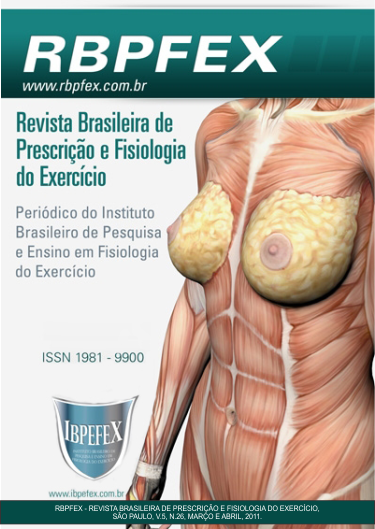Comparison of a session aerobic training and a session of resistance training in levels of delayed muscle soreness in sedentary young adults
Abstract
At the beginning of a training program is known to receive reports of people with muscle pain caused by the training done, so this research is to evaluate and compare an session aerobic training with a session of resistance training on levels delayed onset muscle soreness ( DOMS) in sedentary young adults. The study included 20 people, divided into 2 groups, aerobic exercise (AE) and resistance exercise (RE), the aerobic session was held in a 800m flat track with an intensity of 70% of maximal heart rate and resistance exercise session in gym exercises for the lower limbs with 3 sets of 10-12repetitions at 70% 1RM. In both groups we observed the presence of DOMS at moderate levels, but no significant difference between groups with p> 0.05. The result of this study suggests that resistance exercise at 70% 1RM and aerobic exercise on flat trackto 70%, no significant differences in the values of DOMS in sedentary young adults.
References
-Cardoso, C.G.J.; Forjaz, C.L.M. Comparação de Duas Formas de Predição da Freqüência Cardíaca Máxima em Função da Idade: 220 –idade e 208 –0,7 x idade. XXIV Simpósio Internacional de Ciência do Esporte: Atividade Física, Fitness e Esporte. 11 a 13 de outubro de 2001, p. 174.
-Ellwanger, R.B.; Brentano, M.A. Kruel, L.F.M. Efeito da utilização de diferentes velocidades do treino de força em marcadores indiretos de lesão muscular. Revista brasileira Educação Física e Esporte, São Paulo. Vol. 21. Num. 4. 2007. p. 259-270.
-Foschini, D.; Prestes, J.; Charro, M.A. Relação entre exercício físico, dano muscular e dor de inicio tardio. Revista Brasileira Cineantropometria e Desempenho Humano. Vol. 9. 2007. p. 101-106.
-Matsudo, S.; Araújo, T.; Matsudo, V.; Andrade, D.; Andrade, E. Oliveira, L.C.; Braggion, G. Questionário Internacional de Atividade Física (IPAQ): estudo de validade e reprodutibilidade no Brasil. Revista Brasileira de Atividade Física & Saúde. Vol. 6. Num. 2. 2001. p. 5-12.
-Molina, R; Amorim, A.R. Efeito do dano muscular através e diferentes tipos de exercícios excêntrico sobre a economia de movimento. Revista de Ciências Biológicas e Saúde. Vol. II.2007. p. 89-99.
-Nascimento, C.R.V.; Arruda, S.F.M. Bacurau, R.F.P. Navarro, F. Dor muscular tardia: etiologia e tratamento. Revista Brasileira de Prescrição e Fisiologia do Exercício. São Paulo. Vol. 1. Num. 2. 2007. p. 90-99.
-Rodrigues, C.E.C. Musculação, métodos e sistemas. 3ª edição. Rio de Janeiro. Sprint, 2001.
-Tricoli, V. Mecanismos envolvidos na etiologia da dor muscular tardia. Revista Brasileira de Ciência e Movimento. Brasília. Vol. 9. Num. 2. 2001. p. 39-44.
-Uchida, M. C. Efeito do exercício de força em diferentes intensidades com volume total similar sobre a dor muscular de inicio tardio, marcadores de lesão muscular e perfil endócrino. Tese de doutorado. São Paulo. Instituto de Ciências Biomédicas da Universidade de São Paulo. 2008.
Authors who publish in this journal agree to the following terms:
- Authors retain the copyright and grant the journal the right of first publication, with work simultaneously licensed under the Creative Commons Attribution License BY-NC which allows the sharing of the work with acknowledgment of the authorship of the work and initial publication in this journal.
- Authors are authorized to enter into additional contracts separately for non-exclusive distribution of the version of the work published in this journal (eg, publishing in institutional repository or book chapter), with acknowledgment of authorship and initial publication in this journal.
- Authors are allowed and encouraged to post and distribute their work online (eg, in institutional repositories or on their personal page) at any point before or during the editorial process, as this can bring about productive change as well as increase impact and impact. citation of published work (See The Effect of Free Access).






